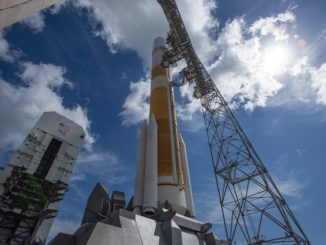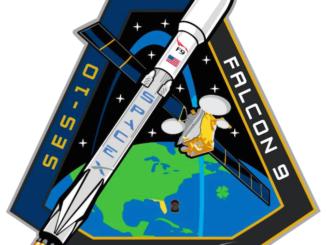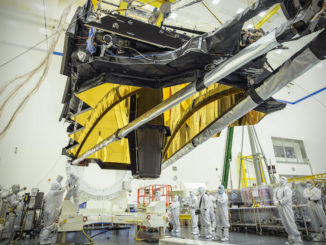EDITOR’S NOTE: Updated at 11 a.m. EDT (1500 GMT) with the resignation of Kirk Pysher as ILS president.
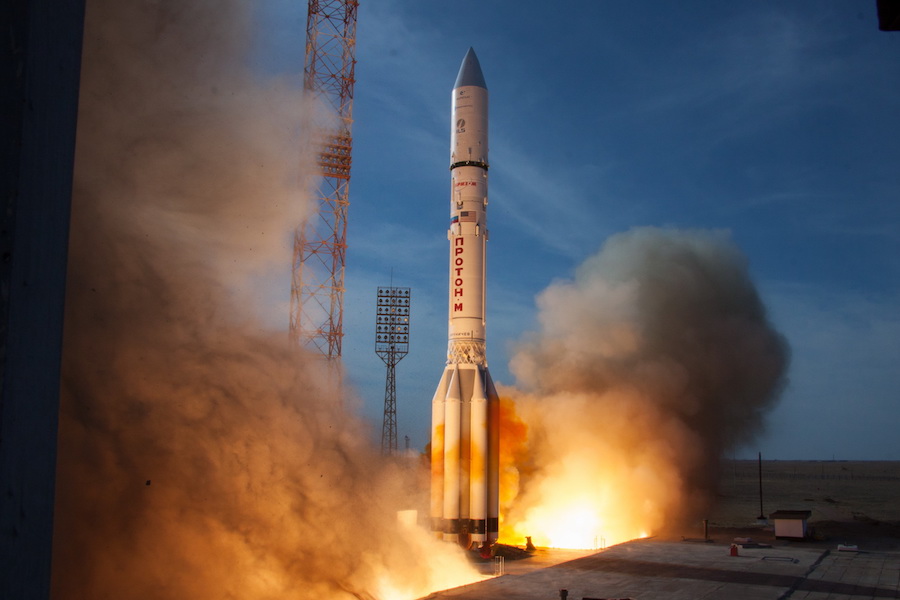
A Proton booster rocketed away from the Baikonur Cosmodrome in Kazaskhtan Wednesday with a Eutelsat television broadcasting craft and the satellite industry’s first commercial in-space servicing vehicle.
The successful launch marked the first commercial Proton mission under the auspices of International Launch Services in more than two years.
The 191-foot-tall (58.2-meter) Proton rocket ignited six RD-276 main engines and climbed away from the sprawling spaceport on the Kazakh steppe at 6:17:56 a.m. EDT (1017:56 GMT; 3:17 p.m. Baikonur time) Wednesday.
The six first stage engines, fed by hydrazine fuel, powered the Proton rocket toward the northeast. All three liquid-fueled stages of the core Proton booster completed their firings in less than 10 minutes.
A Breeze M upper stage separated from the Proton’s third stage to begin a series of five orbit-raising burns to send the Eutelsat 5 West B communications satellite and the first Mission Extension Vehicle — a satellite servicing spacecraft — into a high-altitude elliptical supersynchronous transfer orbit.
The launch sequence spanned nearly 16 hours from liftoff through separation of both satellites from the Breeze M upper stage.
After the Breeze M’s fifth burn, the upper stage deployed the 6,314-pound (2,864-kilogram) Eutelsat 5 West B satellite from the upper position on the rocket’s dual-payload stack. Following a reorientation maneuver, the Breeze M released the Mission Extension Vehicle at 10:12 p.m. EDT (0212 GMT Thursday) to conclude the launch phase of the mission.
The Breeze M’s guidance computer aimed to release the Eutelsat 5 West B and MEV 1 satellites into orbits ranging between around 7,500 miles (12,050 kilometers) to more than 40,000 miles (65,000 kilometers), and an inclination of 13.3 to 13.4 degrees.
The Mission Extension Vehicle launched Wednesday, manufactured by Northrop Grumman, is the first commercial satellite servicing spacecraft ever built. It will dock with an Intelsat satellite in geostationary orbit and take over propulsion, extending the client satellite’s lifetime.
The Eutelsat 5 West B satellite, also built by Northrop Grumman, will replace Eutelsat 5 West A, an aging satellite located in geostationary orbit at 5 degrees west longitude providing TV broadcast services over France, Italy, Algeria, and neighboring regions.
Eutelsat’s newest satellite has a communications payload supplied by Airbus Defense and Space. The satellite carries 35 Ku-band transponders, and the entry into service of Eutelsat 5 West B will help ensure uninterrupted service from the 5 degrees west position.
The spacecraft also hosts a geostationary orbit node for the European Geostationary Navigation Overlay System, or EGNOS, to beam GPS and Galileo navigation augmentation signals to improve position accuracy and reliability. The EGNOS signals provide additional navigation data for use by pilots during critical flight stages, such as final approach and landing.
The European GNSS Agency and Eutelsat signed a 15-year deal in 2017 to accommodate the EGNOS payload on Eutelsat 5 West B. The contract was valued at 102 million euros ($112 million).
“Our congratulations to ILS and Khrunichev for a flawless launch that sees a new Eutelsat satellite propelled on its way to geostationary orbit,” said Rodolphe Belmer, CEO of Eutelsat. ” We look forward to putting Eutelsat 5 West B to work for the benefit of our clients throughout Europe and North Africa and to the inauguration of EGNOS’ GEO-3 payload that will improve the performance of global navigation satellite systems in Europe.”
Eutelsat 5 West B and MEV 1 will use their own propulsion systems to circularize their orbits near geostationary altitude, and reduce their orbital inclinations closer to the equator. The Eutelsat craft will use liquid propulsion for orbit-raising, while the Mission Extension Vehicle will take longer because it relies primarily on new-generation ion thrusters, which generate less thrust but offer fuel efficiency benefits.
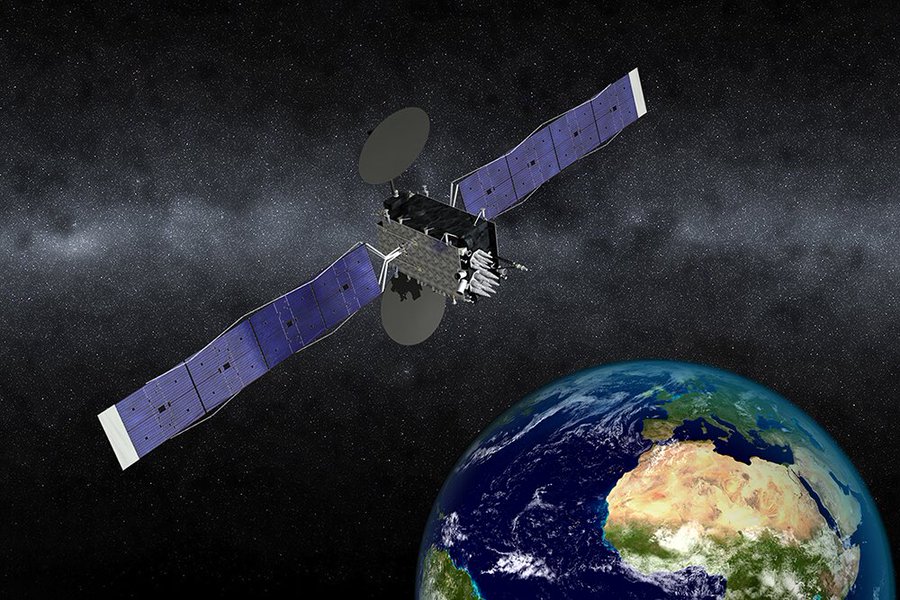
ILS declared success after separation of the Eutelsat 5 West B and MEV 1 satellites, punctuating the company’s first commercial Proton launch since September 2016. It was also ILS’s first launch with two satellites from commercial customers.
The Russian-owned launch provider, based in Reston, Virginia, was once a major player in the commercial launch business. But several factors have diminished ILS’s place in the market, including SpaceX’s dominance in recent years with lower launch prices, a shift in the market from large communications satellites to smaller spacecraft, and reliability concerns with the Proton and Breeze M vehicles themselves.
ILS said Wednesday’s mission was the Proton’s 18th consecutive success since a failure in 2015, building up the Proton’s five-year reliability to more than 95 percent.
During that time, Proton rocket-builder Khrunichev has introduced new quality control processes in its factory in Moscow to improve the rocket’s reliability. The changes included creating new data books, camera inspections, new machinery, and automatic electric data logging from manufacturing tools, according to ILS.
“With today’s added demonstration of Proton dual-launch capability, ILS looks forward to supporting a broad range of changing spacecraft requirements,” said Kirk Pysher, president of ILS, in a statement.
Khrunichev, builder of the Proton rocket and majority owner of ILS, announced the resignation of Pysher Thursday. The resignation was unexpected, and Pysher did not mention his departure in a pre-launch interview with Spaceflight Now.
John Palme, ILS’s chief operations officer, will serve as interim president of the company, officials said.
Before Wednesday’s mission, Pysher said ILS has no near-term commercial launches planned after the Eutelsat 5 West B/MEV 1 mission. One more Proton launch is scheduled this year to loft a Russian government weather satellite into orbit.
ILS has agreements with Eutelsat and Intelsat, which operate two of the largest commercial satellite fleets in geostationary orbit, for multiple future Proton launch opportunities. But neither company has announced a firm payload assignment to launch future satellites on the Proton rocket.
Commercial launches using Russia’s new Angara rocket family are also arranged by satellite operators through ILS. A South Korean radar imaging satellite named Kompsat 6 its booked to launch on an Angara 1.2 rocket, the smallest member of the Angara family. The launch of Kompsat 6 from the Plestesk Cosmodrome was supposed to occur in 2020, but Pysher said delays in the satellite’s readiness have pushed back the Angara 1.2 launch “significantly.”
“All those are, at this point, still active contracts, and we’re working on those,” Pysher said of ILS’s agreements with Eutelsat and Intelsat, and the contract for Kompsat 6’s launch with the Korea Aerospace Research Institute.
Wednesday’s mission was also the first for ILS since Glavkosmos — an enterprise owned by the Russian government — took over control of the launch provider.
Read our earlier story for details on the reorganization in ILS governance.
“We are seeing the benefit by having this relationship with Glavkosmos,” Pysher told Spaceflight Now Tuesday. “It truly is allowing us to be closer to Roscosmos (Russia’s space agency) and getting their support when we need it for obtaining launch licenses, and getting clearances to access Baikonur, etc. So those things we’re really seeing a difference there.
“We have somewhere else to turn to,” he continued. “Before we were just dealing with Khrunichev, and now we have that direct link into Roscosmos, and it’s definitely bearing fruit.”
In the long term, ILS sees an opportunity in its relationship with Glavkosmos and Roscosmos to diversify its offerings. ILS currently provides commercial launch services on Russia’s Proton heavy-lifter and the light-class Angara 1.2 rocket. In the future, ILS seeks to add the medium-lift Soyuz rocket to its portfolio, taking over Soyuz marketing and sales functions from Glavkosmos’s subsidiary GK Launch Services for customers in the Americas, and possibly Europe.
“It’s still relatively new, so we’re still working to get the rest of the program up and running where we’re marketing Soyuz and other products,” Pysher said. “Those things are still in work. We’re not quite there yet. I would say that everything we had hoped for so far is materializing.”
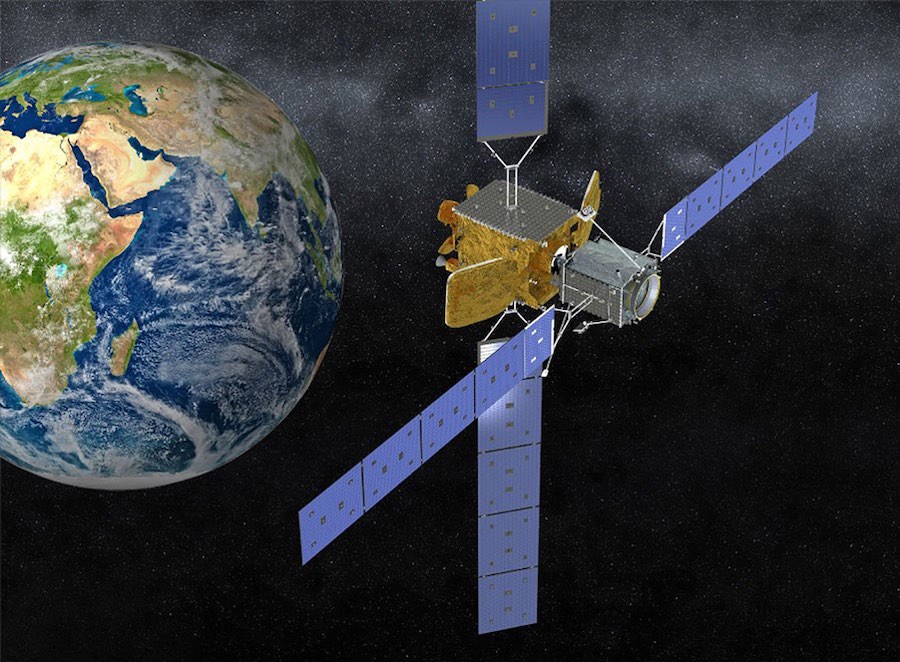
The MEV 1 spacecraft is owned by Space Logistics LLC, a wholly-owned subsidiary of Northrop Grumman. Using ion thrusters, the spacecraft will gradually circularize its altitude to geostationary altitude over the next three-and-a-half months, according to Joe Anderson, vice president of business development and operations at Space Logistics.
In the meantime, Intelsat controllers will send commands for the Intelsat 901 satellite to leave its operating position at 18 degrees west longitude and raise its altitude by nearly 200 miles, or 300 kilometers, to the so-called GEO graveyard orbit, where geostationary satellites are typically decommissioned.
“We will then, probably in the late January timeframe, rendezvous and dock with the spacecraft in that graveyard orbit,” Anderson said in an interview with Spaceflight Now. “We will do a little bit of testing there to demonstrate the capabilities of the combined stack, and then we will begin relocating it to its new operational location.”
The Mission Extension Vehicle will attempt its first docking in the GEO graveyard orbit to reduce the risk to other active satellites from space debris in the event of an accident.
The MEV is different from other satellite servicing concepts because it is strictly used for steering, pointing and relocating another spacecraft that is running low on propellant. The servicer will not refuel Intelsat’s satellites, which were never designed for dockings.
The Mission Extension Vehicle will latch on to the main engine of Intelsat 901, and other future client satellites. A liquid apogee engine is mounted to the base of about 80 percent of the communications satellites in geosynchronous orbit. The thruster is only used in the first few weeks after launch to put the satellite into its final orbit, then never fired again.
The approaching spacecraft has a stinger that reaches into the apogee rocket engine’s nozzle from about 3 feet (1 meter) out, and mechanical fingers will reach out and grab the target craft to pull the two satellites together.
The MEV has two deployable propulsion pods with efficient electric thrusters, little engines that generate very low thrust but can operate for hours or days at a time. There is also a small tank of liquid hydrazine fuel on-board, mainly for higher-impulse maneuvers during the docking sequence.
Ground teams at Northrop Grumman’s control center in Dulles, Virginia, and at Intelsat’s operations center in nearby Tysons Corner will oversee the rendezvous. Visible and infrared cameras, along with a scanning LIDAR sensor will collect range and closure rate data to feed into the MEV’s flight computer, while ground teams supervise the approach.
“As we approach the client, we sort of spiral in, circumnavigating the client and getting closer and closer until we achieve a position that’s about 80 meters (262 feet) behind the client satellite,” Anderson said. “At the 80-meter point — we call that a far hold — the MEV will stop at that location, and it will wait for ground command to proceed. This is where the supervised autonomy comes in.
“At this first waypoint, it waits for a ground command to say you have permission to proceed to the near hold point. So we give it the command to proceed, and it will autonomously go from the 80-meter far hold to the 20-meter (65-foot) near hold point. And then it will stop again at that 20-meter near hold point awaiting ground command to proceed on to the final waypoint, which is about 1 meter (3.3 feet) behind the client,” Anderson said.
“A ground command will give it permission to proceed on to that one-meter point, to the capture hold point. It will stop at the capture hold point, and then it will wait for ground command to tell it to go ahead and proceed with docking,” he said. “Once it receives that, it will autonomously complete the docking procedure.”
Officials plan a rendezvous rehearsal before attempting an actual docking. During the practice run, the MEV will close in to a distance of 262 feet from Intelsat 901 before backing off.
Once the satellites are docked, the MEV takes over attitude control and propulsion responsibilities, acting like a jet pack for the customer spacecraft.
The MEV’s fuel-efficient, xenon-fed ion thrusters will steer the Intelsat 901 satellite toward a new operating post at 27.5 degrees west longitude. Intelsat 901’s current orbit takes the satellite about 1.5 degrees north and south of the equator during each 24-hour orbit.
The Mission Extension Vehicle will guide Intelsat 901 back to a position directly over the equator.
“As we’re relocating into that new operational location, we will reduce the inclination,” Anderson said. “So we will remove that degree-and-a-half of inclination, so that when it is brought back into service, it will be fully station-kept. Intelsat will then operate the IS-901 spacecraft from that location for at least five years. They have an option to extend a couple more years if they wish.
“At the end of that five-year period, we will take the IS-901 satellite back to the graveyard orbit and undock from it there,” he said. “And then the MEV will move on and go to its next customer. The MEV is a multiple use spacecraft, and it will serve multiple clients during its lifetime.”
The Intelsat 901 satellite launched in June 2001 aboard an Ariane 4 rocket for a mission originally designed to last at least 13 years.
Intelsat, one of the world’s largest and oldest commercial satellite operators, signed up as the anchor customer for the Space Logistics satellite servicing program in 2016.
Satellite servicing is not new for Intelsat.
Astronauts flying on the space shuttle Endeavour installed a new upper stage on the Intelsat 603 satellite in 1992. Over the course of three spacewalks, Endeavour’s crew struggled to capture the cylinder-shaped communications satellite, which was stranded in an unusable orbit by a launch failure.
After two capture attempts turned up empty, space shuttle crew conducted the first — and so far only — spacewalk to be performed by three astronauts to grab the 4.5-ton satellite and connect a new kick motor to send it into geostationary orbit.
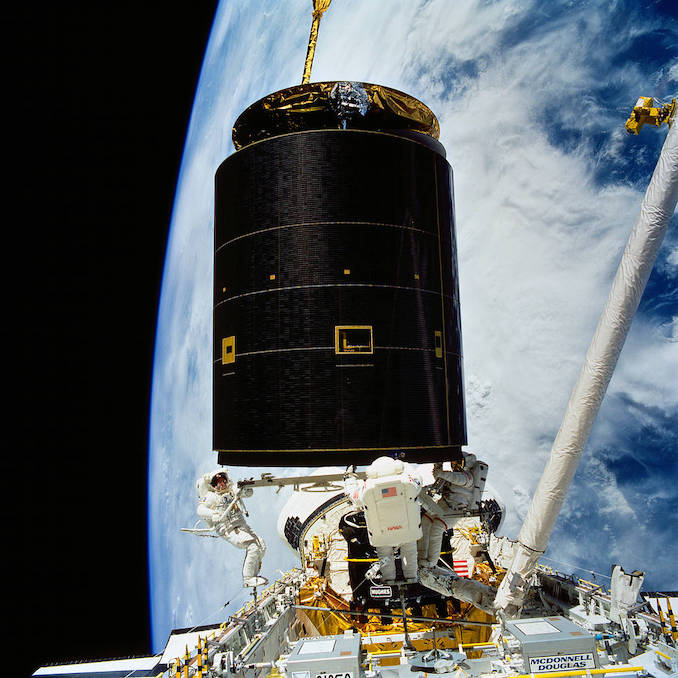
Ken Lee, Intelsat’s senior vice president of space systems, said in 2016 that Intelsat was excited about the capabilities of the Mission Extension Vehicle.
“From our perspective, it’s one of the tools in our toolkit,” Lee said. “So not all our satellites will have this business plan, but there are certain spacecraft that may suit well for this capability.”
The second Mission Extension Vehicle, set for launch in the second quarter of 2020, will also service an aging Intelsat communications satellite in geostationary orbit. The MEV 2 spacecraft will launch on top of an Ariane 5 rocket in tandem with Intelsat’s new Galaxy 30 communications satellite.
Customers can purchase MEV services on an annual basis.
For the MEV 1 mission, Intelsat is paying around $13 million per year for the life extension service, said Jacques Kerrest, Intelsat’s executive vice president and chief financial officer, in a quarterly earnings call earlier this year.
Northrop Grumman’s satellite servicing program has weathered several corporate mergers and acquisitions. The Mission Extension Vehicle started under ATK, a precursor to Orbital ATK, which formed in 2015. Northrop Grumman acquired Orbital ATK in 2018.
Anderson said the MEV relies on existing technologies.
The navigation sensors flown on the MEV are similar to rendezvous aids used on Northrop Grumman’s Cygnus space station supply ship, and the MEV spacecraft is based on Northrop Grumman’s flight-proven GEOStar design. The MEV also uses a docking structure based on devices developed by ATK for space shuttle servicing flights to the Hubble Space Telescope.
Maxar, a competitor with Northrop Grumman the satellite manufacturing business, is developing the Restore-L satellite servicing demonstration mission under contract to NASA that aims to refuel a Landsat Earth-imaging satellite, which orbits around 50 times closer to Earth than the geostationary altitude targeted by the the MEV.
Space Logistics received technical assistance from NASA during development of the MEV, but the government provided no funding. NASA’s assistance included support tasks in rendezvous and proximity operations, management of electro-static discharges between vehicles, robotics operator training, and the development of electric propulsion systems, the space agency said.
Maxar’s Restore-L mission is more technically complex, and involves the transfer of propellant and an in-space manufacturing and assembly demonstration with robotic arms. The MEV is simpler, and it’s a purely commercial effort.
But NASA and the U.S. military could be future customers for Space Logistics. The Aerospace Corp., a support contractor for government space programs, has a contract with Space Logistics to study the potential use of the company’s life extension services for U.S. military satellites.
“Once this capability has been demonstrated on MEV 1, NASA has the option of acquiring such a service in the future through a straightforward commercial acquisition instead of having to develop the capability ourselves at taxpayer expense,” said Phil McAlister, director of the commercial spaceflight division at NASA Headquarters. “It is big win for Northrop Grumman, NASA and the nation.”
“We do we foresee, eventually, moving into refueling,” Anderson said. “Currently, we believe that best approach for that is for satellites that have been prepared for refueling, versus trying to refuel satellites that have been launched without the compatible features that are necessary to do that.
“However, with that said, our strategy, versus some of our competitors and some of the things NASA has been looking at, has really been to keep it simple, and to incrementally add technology,” Anderson said. “The technology has been sufficiently validated, the risks are low enough, so that the risk level is compatible with the tolerance of our clients, so that we can sell those services.”
Space Logistics has plans for future satellite servicing vehicles. That may include additional MEVs, although there are no immediate plans to build a third Mission Extension Vehicle, Anderson said.
Instead, Space Logistics is developing a more advanced servicing vehicle with robotic arms that could attach propulsion packs directly to client satellites. Ion thrusters on the propulsion packs, or Mission Extension Pods, could provide orbit control services to a customer satellite for up to six years.
“Today, we feel refueling is a little bit of a longer stretch in terms of the incremental technology step,” he said. “So that’s why we chose to go to the MEV, and now to our Mission Extension Pods. But we do think refueling is is very quick to follow on the heels of our Mission Extension Pod concept, and we do look forward to getting to that approach.”
Email the author.
Follow Stephen Clark on Twitter: @StephenClark1.

